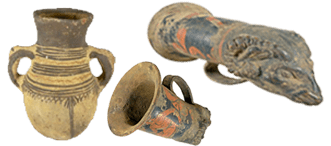Few things are more exciting than adding special pieces to a collection. Whether you collect artifacts, ancient coins, fossils, minerals, crystals or other antiquities from around the world, Ancient Artifacts & Treasures, Inc. has the inventory selection for you.
THE POOR WIDOW’S MITE

Ancient Artifacts & Treasures, Inc.
“And Jesus sat over against the treasury, and beheld how the people cast money into the treasury: and many that were rich cast in much. And there came a certain poor widow, and she threw in two mites, which make a farthing. And he called unto him his disciples, and saith unto them. Verily I say unto you, That this poor widow hath case more in, than all they which have case into the treasury: For all they did cast in of their abundance; but she of her want did cast in all that she had . . . (Mark 12:41-44)”
Since Jesus made such a point of how little this poor widow had in the way of wealth and how little she threw into the treasury, there is little doubt that the “Widow’s Mites” were the smallest coins in circulation in Jerusalem at the time.
A widows mite is any of the small bronze Leptons minted in Judea from 135 BC to the first revolt in 66 – 70 AD. This usually includes the small bronze coins minted by Herod the Great – 37 BC to 4 BC, Herod Archelaus – 4 BC to 6 AD, and the Procurators Comonius – 6 AD to 9 AD, Marcus Ambibulus – 9 – 12 AD, Valerius Gratus – 15 – 26 AD, Pontius Pilate – 26 – 36 AD and Antonius Felix – 52 – 54 AD. However, it usually refers to the coins struck during the reign of Alexander Jannaeus (103-76BC) that had an 8 pointed star on one side and an anchor on the other. These were the most common of the small leptons during the time of Jesus.
The name “Widow’s Mite” was created when some early writers of the King James Bible in 1611 made the error of calling the six-pointed star on some of the Leptons a mite. To many people the crude star appears to be a tiny bug or “mite.” Thus, the smallest coins in circulation in Jerusalem during the time of Jesus were known as “Widow’s Mites.”



Comments are closed.